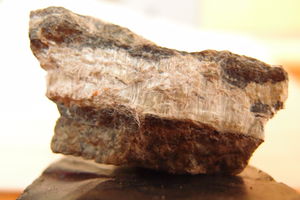Difference between revisions of "Asbestos"
| Line 14: | Line 14: | ||
==Projects== | ==Projects== | ||
*Thermal insulation | *Thermal insulation | ||
| − | *Platinized asbestos | + | *[[Platinized asbestos]] |
*Mineral collection (especially the colored varieties) | *Mineral collection (especially the colored varieties) | ||
Revision as of 20:19, 23 November 2019
Asbestos is a group of six naturally occurring fibrous silicate minerals (chrysotile, tremolite, anthophyllte, amosite, crocidolite and actinolite), used in the past as an insulator material, but has largely been replaced due to its potent carcinogenic effects.
Contents
Properties
Chemical
Asbestos is chemically resistant to the attack of many weak acids, but less so with alkali. Molten alkali will react even faster with asbestos than aqueous alkali.
Physical
Asbestos is a natural fibrous mineral, that is usually white, but blue and brown varieties are also known. Individual asbestos fibers have a diameter between 3–20 µm, some even 0.01 µ, making them nearly invisible to the naked human eye. Asbestos is a good heat and electrical insulator.
Availability
Asbestos is less common these days, as its use in many commercial products has been phased out. Older appliances, such as old electric heaters, are a source of asbestos, but due to its hazard, proper protection, such as gloves, masks, coat is required when recovering asbestos. Certain old nichrome resistors also have asbestos insulation.
Projects
- Thermal insulation
- Platinized asbestos
- Mineral collection (especially the colored varieties)
Handling
Safety and Toxicity
Asbestos is a well known carcinogenic. Inhaling asbestos fibers has been linked to many illnesses such as asbestosis, mesothelioma and malignant lung cancer. On contact with skin or sensitive body parts it can cause irritations.
Storage
While bulk asbestos fiber is safe to use and store, the small airborne fibers are the greatest hazard. It should be stored in a place without any draft, to prevent the small fibers from getting airborne.
Disposal
Asbestos should be sent to proper disposal facilities. Asbestos can also be mixed with cement, though that too should be taken to the disposal centers.
An interesting method of neutralizing asbestors involves oxalic acid and ultrasounds. The asbestos fibres are introduced in an aqueous solution of oxalic acid of 0.5 M concentration (pH = 1), in a cavitating tube. The source of ultrasounds is a cup-horn ultrasound generator (19.2 kHz), where the vibrating surface consists of a vertical 100 ml hollow titanium cylinder. The sono-chemical treatment takes place over the course of 3-21 h. The resulting waste contains only fibrils of irregular serpentine polymorph antigorite, which has low toxicity and does not require special disposal.[1]
